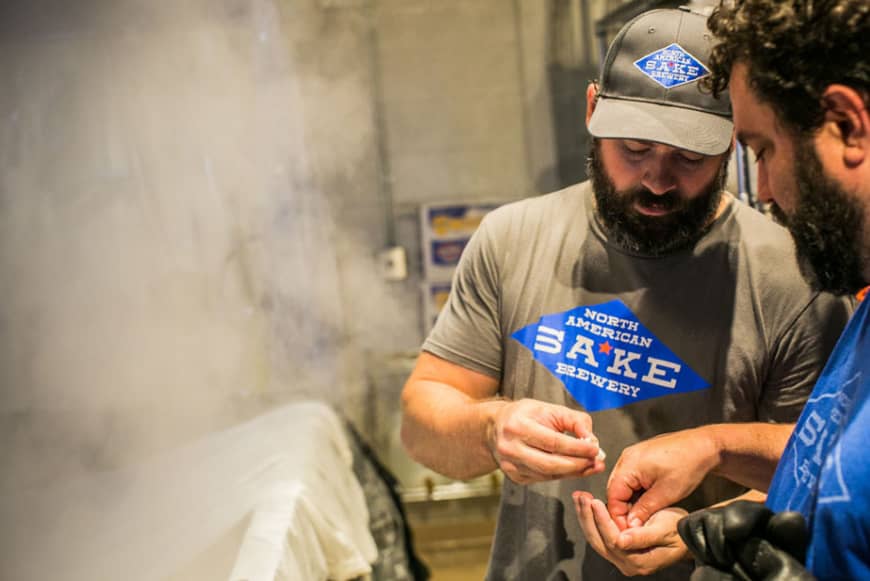
MAY 4, 2019 BY KO HIRANO,KYODO
CHARLOTTESVILLE, VIRGINIA – With the growing demand for sake in the United States, American craft brewers are also getting in on the act — and giving Japan’s “drink of the gods” their own twist.
North American Sake Brewery in Charlottesville, Virginia, is the latest in a wave of craft sake producers in the U.S., the world’s largest sake consumer outside Japan.
“Japanese sake brewers are targeting the United States as the place for the most growth. I think that says a lot about where we’re heading,” says North American Sake Brewery co-founder Jeremy Goldstein.
According to Japanese government data, in 2017 the value of Japan’s sake exports expanded about 20 percent from just a year earlier to reach a record ¥18.68 billion (about $170 million). Of the total, shipments to the United States came to ¥6.04 billion (about $54 million).
“In the U.S., what drives the future of the sake business is not just the traditional but the experimental,” says Goldstein. “Look at the craft beer industry and how they play with different flavor profiles and infusions. This is where we are going. This is how we grow.”
Including the Charlottesville operation, there are 21 sake breweries in the United States, up from an estimated five in 2000, according to Timothy Sullivan, a New York-based sake expert.
The growing popularity of sake — and the increasing number of breweries — in the U.S. reflects the rise of Japanese food culture in the country, say American sake experts.

“Over the past five years I have seen an increase in demand for many Japanese ingredients — fish, meat, produce and seasonings — from everyone from Michelin-star chefs to your local neighborhood spot,” says Jessica Joly, a New York-based sake sommelier.
“With all this hype comes a demand for a Japanese beverage as well, which is sake,” continues Joly, who was named “Miss Sake USA” in 2016 by the Miss Sake Association in Japan for her role in promoting the beverage in the United States.
“Sake continues to grow in sales each year and most likely will continue to rise in the years ahead,” she says.
Forgoing his career as a film writer, Goldstein started a sake venture three years ago in Charlottesville — the first of its kind in Virginia — with his business partner and chief brewer Andrew Centofante.
Goldstein says he became a sake “fanatic” after tasting “good craft sake for the first time” at a high-end restaurant in Los Angeles, his hometown.

As Centofante began brewing sake at home on a trial basis, he and Goldstein visited U.S. craft sake breweries such as Blue Current Brewery in Maine, Brooklyn Kura in New York, SakeOne in Oregon, Ben’s Tune Up in North Carolina and Proper Sake Co. in Tennessee.
“We visited sake breweries in the U.S., asked them questions, brewed with them and learned a little bit about how it’s made,” says Centofante, a Virginia native who left his marketing career behind for the new venture.
Using California-grown Calrose and Arkansas-grown Yamada Nishiki rice, the Charlottesville brewery’s current annual production capacity is 43.2 kiloliters — or 54,000 750-milliliter bottles.
This year, it aims to sell 50,000 bottles of six varieties of sake, such as its Real Magic junmaishu (sake made without additional distilled alcohol) or Spicy Vacay, its more playful, less traditional, sake that’s inflused with mango, lime and jalapeno.
Experts have lauded the emergence of American breweries, such as North American Sake Brewery and Brooklyn Kura, that supply locally made sake to U.S. consumers.
“They are not trying to create a replica of Japanese sake,” Joly says. “They are taking inspiration and techniques, but creating their own brand.

“What makes American sake unique is that many sake brewers come from craft beer brewing, which definitely adds to the unique styles of American craft sake,” she continues. “You might see some sake with added flavoring or simply dry hops added, which you would never see in Japan.”
While the number of American sake breweries is expected to increase, partly due to the interest among more craft beer brewers in making sake, experts believe the Japanese sake industry does not view American players as its rivals in the U.S. market, but as entities with which it can coexist.
“So far, the Japanese industry, including the government, is quite supportive of sake brewing overseas,” says John Gauntner, a Japan-based sake expert known as “the Sake Guy” and “the Sake Evangelist.”
“I think that this is because they know that it will help the awareness of sake to grow,” he says. “It will also help sake made in Japan to become more appreciated and sell better.”
Sharing Gauntner’s view, Joly says that, unlike past generations of sake brewers, the younger generation of sake brewers in Japan, the U.S. and elsewhere are much more adventurous and curious about taking a different approach to the drink.
“This is just the beginning,” she says. “I’m excited to see what the next five to 10 years will look like.”
For more information about North American Sake Brewery, visit pourmeone.com.
